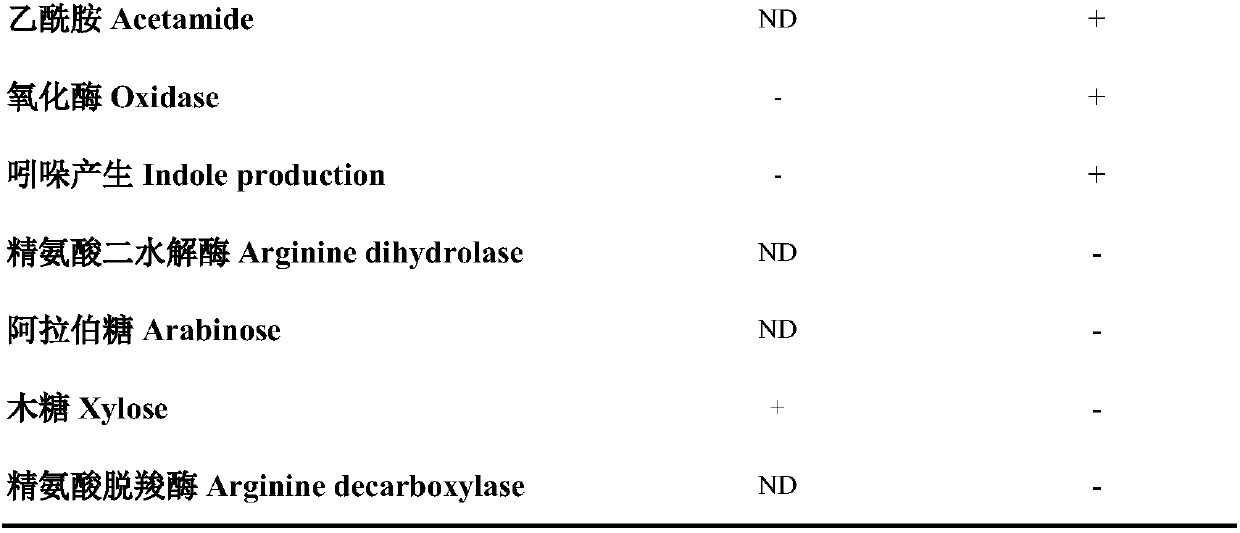Ocean phosphorus-dissolving bacillus megaterium and application thereof
A technology of Bacillus megaterium and phosphate-solubilizing bacteria, which is applied to marine Bacillus megaterium phosphate-solivating bacteria SCSIO43701 and its application fields, can solve problems such as branch growth and root dry weight, and achieve good growth, accelerated repair, and growth-promoting effects
- Summary
- Abstract
- Description
- Claims
- Application Information
AI Technical Summary
Problems solved by technology
Method used
Image
Examples
Embodiment 1
[0021] Example 1: Isolation, purification and identification of Bacillus megaterium SCSIO 43701
[0022]The deep-sea samples used to isolate microorganisms are deep-sea samples from the northern part of the South China Sea (2011), and the specific depth of collection is: 3928m; the site is 118°30.989E, 18°5.255N; the separation medium used is a diluted 10% 221E medium: the specific components are peptone 0.1g, yeast extract 0.5g, FePO 4 0.01g, (NH 4 ) 2 SO 4 0.4g, CaCO 3 0.1g, agar 12g and seawater 1000mL, pH 7.2-7.4. Weigh 0.2g sediment sample into 18mL sterilized seawater, dilute to 10 -1 、10 -2 、10 -3 3 dilutions, spread on the plate, and after obvious colony grows, transfer to spread until a single bacterium is found. The bacterial strain SCSIO 43701 was thus isolated and purified.
[0023] 1.1 Morphological and molecular biological identification of Bacillus megaterium SCSIO 43701
[0024] Through Gram staining and microscopic examination, the results showed...
Embodiment 2
[0036] Example 2: Determination of organophosphate degradation activity of Bacillus megaterium SCSIO 43701
[0037] The method used for the detection of the phosphorus-solubilizing activity of Bacillus megaterium SCSIO 43701 is the molybdenum-antimony antichromogenic method, and a single colony is picked and inoculated into 100 mL of improved selective liquid nitrogen-fixing medium (the specific composition of the improved selective liquid nitrogen-fixing medium is: FeSO 4 ·7H 2 O 0.001g, KCl 0.56g, MgCl 2 ·6H 2 O 4.00g, NaCl 25.00g, MgSO 4 ·7H 2 O4.80g, K 2 HPO 4 0.01g, Tris 0.48g, peptone 4.00g, yeast extract 2.00g, glycerol 2.00mL and deionized water 1.00L, pH 8.10, add 18.00g agar to the solid medium) Erlenmeyer flask, set up the experimental group and the control group , wherein the experimental group was inoculated with 1% bacterium liquid and the control group was inoculated with 1% sterile water, placed at 28°C, and after cultivating at 180rpm for 24h, it was tr...
Embodiment 3
[0038] Example 3: Bacillus megaterium SCSIO 43701 is used for toxicity identification experiment
[0039] This experiment was completed in Guangdong Provincial Microbial Analysis and Testing Center. Pick a single colony of Bacillus megaterium SCSIO 43701 and inoculate it in an improved selective liquid nitrogen-fixing medium (the formulation of the improved selective liquid nitrogen-fixing medium is the same as in Example 2) and cultivate it at 30°C for 3 days, and adjust the concentration of the bacterial solution to 2.0×10 8 ~2.0×10 9 cfu / mL, 20 KM variety SPF grade mice used in the test, half male and half male, the growth environment is room temperature 24-28°C, relative humidity is (40-70)%, raised in group cages, 10 / cage.
[0040] The specific method of the toxicity detection experiment is strictly in accordance with the "General Technical Guidelines for Biosafety of Microbial Fertilizers NY 1109-2006", the dose is 5580mg / kg·BW, and according to the requirements of the...
PUM
 Login to View More
Login to View More Abstract
Description
Claims
Application Information
 Login to View More
Login to View More - R&D
- Intellectual Property
- Life Sciences
- Materials
- Tech Scout
- Unparalleled Data Quality
- Higher Quality Content
- 60% Fewer Hallucinations
Browse by: Latest US Patents, China's latest patents, Technical Efficacy Thesaurus, Application Domain, Technology Topic, Popular Technical Reports.
© 2025 PatSnap. All rights reserved.Legal|Privacy policy|Modern Slavery Act Transparency Statement|Sitemap|About US| Contact US: help@patsnap.com



